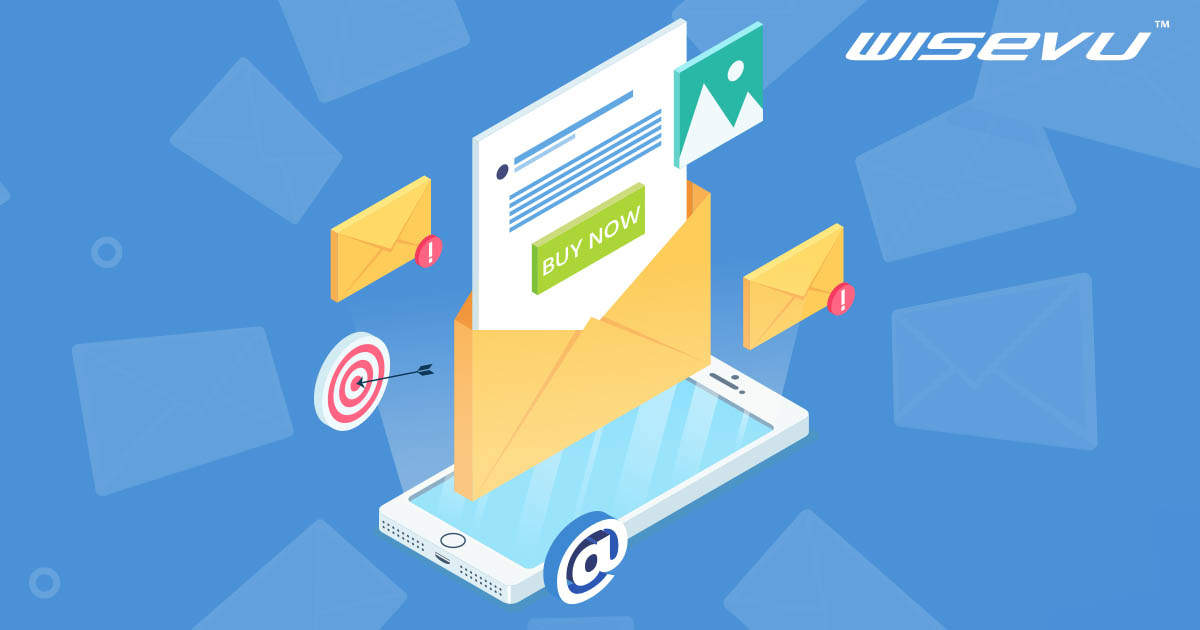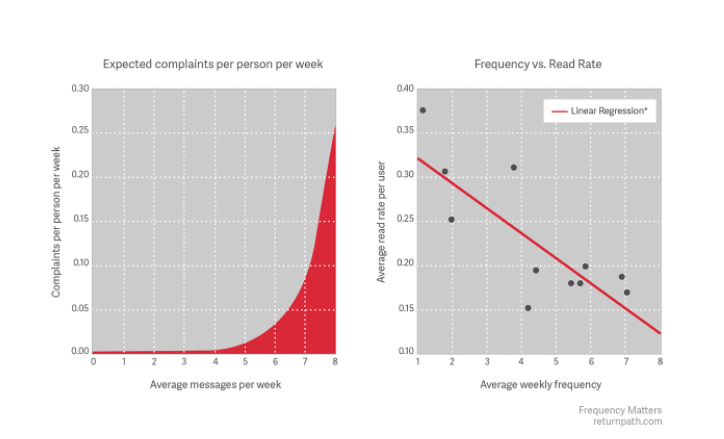Simple and Effective Ways to Improve Email Deliverability
According to OptinMonster, email marketing can provide returns on investment of up to 4,400%. In order to get such types of returns, you have to be attentive and meticulous in the way you approach your email marketing campaigns. Wisevu can help optimize your email marketing for maximum ROI with our premium email marketing services
There is a good deal of email metrics such as click-through rates, open rates, conversion rates, bounce rates, and list growth rates to track email campaign success. However, the one metric that is often given less attention and importance and arguably is the most important one is email deliverability. It is the foundation upon which an entire email marketing strategy rests.
Before you figure out how your target audience is responding to your emails, deliverability will help you figure out if your emails are even getting through. The deliverability rate of specific software like ActiveCampaign is 95.6% and that of MailChimp’s is 84.9% according to EmailToolTester. SendX has an even better deliverability which is 99.4%.
A disheartening number of emails don’t make it to the inbox. However, with a few insider trade secrets, you can see solid improvements to your email deliverability rate immediately.
Here are some email tips to help you nail email delivery
1. Subscriber origin
The email addresses in your list must belong to real users who actually want to be on your list.
2. Have a clean list
Use an email verification tool such as ZeroBounce, Mailfloss, and NeverBounce to check for generic addresses (info@gmail.com), and addresses with typos.
3. Adjust your DMARC settings
Update your DMARC (Domain-based Message Authentication, Reporting, and Conformance), SPF (Sender Policy Framework), and DKIM (Domain Keys Identified Mail) policies. Also, maintain proper IP allocation, and verify your email domain.
For Example: When we questioned regarding the change of the sender email from discover@domain1.ca to info@domain2.ca in MailChimp, MailChimp notified that emails from different domains can be sent but, it is to be ensured that the domains are authenticated.
Have a look at the Email Domain Authentication process at MailChimp.
DMARC – DMARC helps to determine whether the given message/email is from the legitimate sender.
It identifies spam and phishing messages and keep them away from the receivers’ inboxes. The legitimate owner of the domain can also request for any spoofed spam /phishing messages to be moved directly to the spam folder. DMARC guides email senders and receivers to work towards secure emails and protect from unauthorized messages.
SPF – SPF is an email-authentication technique that prevents spammers from sending emails from the sender’s domain.
SPF validates and protects the sender’s domain from spoofing and ensures that the message has been delivered to the correct destination. It specifies the permitted email servers who can send email on behalf of the sender’s domain.
DKIM – DKIM is an email security technique that ensures messages aren’t altered during the transmission between the sender and recipient servers. A public-key cryptography is used to sign email while leaving the sender server. The public key is used by the recipient server to verify the message and ensures that the body of the message has not been changed during the transmit. After the message has been passed through DKIM it is considered to be authentic.
4. Use double opt-ins
To make sure your recipients really want to be on your list. Use double opt-ins where contacts have to go through an additional step to confirm their sign-up via a verification link that is sent to their email after they subscribe.
5. Give options to the recipients
Due to the introduction of the CAN-SPAM Act and CASL, you must give recipients the option to choose the frequency, topic, and ability to unsubscribe, and more. This info must be placed in the email subscription form and compliance (eg- By signing up you agree with our terms and conditions. In the policy, you can mention GDPR or CASL). Related info can be added in the email footer.
6. Keep HTML to a minimum
Avoid adding many HTML tags or codes in your email template. Such types of emails always end up in the promotions or worse in the spam tab. Concentrate on the body of the email with a crisp and concise content. Make sure the email to be text based and include images only if necessary. Too many images on the body of the email may look clustering reducing the value of the email.
7. Avoid adding links to your social media profiles
Adding too many links to your email which increases the chance of not getting delivered to the inbox. Include links to your email only if necessary. It’s easy to fill your email with links and CTAs but it would overwhelm your readers even with the emails landing in their inboxes.
8. Avoid trigger words
Usage of trigger words in the subject line or email will increase the chances of your email to get trapped in SPAM filters. Trigger words like, sale, hurry, discount, credit, free, fast cash, last chance, limited time offer, do it today, deal, refund, full refund, act now, apply now, call now, limited offer, offer expires and more. Avoiding these words will help your email to get through SPAM filters. Click here to learn more about the trigger words you should avoid.
9. Segment
Divide your email list into groups based on characteristics such as interests, demographics, industry, or purchasing behavior. If your email list wasn’t built in the right way, then you will face deliverability problems. Unless you rebuild the list the right way, you will continue to experience issues. According to HubSpot, marketers who use segmented campaigns note as much as a 760% increase in revenue. 35% of marketers send their customers 3-5 emails per week. So, segment your emails as it will help to improve email open rates, boost click rates, and reduce unsubscribe rates.
10. Consistency
Many studies have been conducted to find out the best times to send emails. Draw inspiration from the research of others and conduct your own experiments so you can be consistent.
For example, let’s say you have 10,000 opt-ins. But your messaging after the opt-in is not consistent, and you’re not meeting the expectation you set. This will also lead to deliverability issues.
When it comes to sending emails, you just have to find out the right balance. If you send too seldom, email subscribers will forget you, if you send too often, subscribers will get annoyed. Here is a chart from validity’s Frequent Matters report.
From this chart, you can see that the complaints increased and read rates decreased when the email frequency increased, leading to deliverability issues. So, always test the ‘send frequency’ to find out the right balance and increase your chances of happy recipients.
11. Tweak subject lines
According to Marketo, the ideal subject line length is about 40 characters or seven words. So rely on segmenting and testing to polish your subject lines. You can also personalize subject lines by adding first names, interests, birthdays/anniversaries, and implementing questions but, remember not to make the subject line sound or look promotional. Pay attention to the preview that follows the subject line as it is a valuable piece that must not be ignored. The preview/preheader text appears in your reader’s inbox right after the subject line. This preview text usually contains details like browser information and most of the popular Email Service Providers offer a space of 35-90 characters which helps in adding value to your subject line. Ensure not to fill your subject line with spammy words like Act Now, Order Now, Credit, Cash Bonus, Obligation, Cheap, Promise, and more such words, will be filtered by spam filters resulting in email deliverability issues for email. To avoid all such situations, you can use tools such as CoSchedule’s email subject line tester to test the overall subject line quality.
12. Final check
Run your emails through spam checking tools such as PutsMail or Mailtrap as these tools will provide suggestions before your final send-off.
13. Create a plan to engage with inactive subscribers
If you have a group of inactive subscribers who haven’t opened your emails for quite a while, you should not send them emails every week. You can also set a rule and create a separate segment for these inactive subscribers and create a different strategy on how often you should be mailing them. Using Automations Mapping will help segment inactive users into corresponding lists where less frequent emails are sent. Alternatively, you can use a different messaging medium to try to re-engage them. If nothing works out, you can eventually delete them. This can all be set up using Automations so there is no need for manual work. Wisevu specializes in Email Automations Mapping and implementation using Active Campaign and Mailchimp.
How Email Providers like Gmail or Outlook Measure Reputation?
Email reputation is considered to be an important score for an email marketing campaign. When your score is higher you seem to have good engagement with your target audience and email deliverability. If your reputation score is low, it means your email delivery is not successful and is failing to reach your audience. Whether it is good or bad, your email reputation has a great impact on email deliverability. Below are some of the measurements on how the email providers measure email reputation.
- Open rates – An open rate can sometimes be misleading (1% of an open rate for 100,000 emails sent is 1000). So, you can look into an open volume instead of just an open rate
- Complaint rate (marked as spam)
- Bounce rates (sending emails to invalid addresses)
- Sending to inactive accounts
- Spam trap hits (sending emails to accounts that basically didn’t sign up)
- Delete without reading rates (when people are deleting without even reading)
In some cases, when an email is kept unopened for londer duration it may have a negative impact as well.
In some cases, it would create a negative impact when an email in the inbox is kept unopened for a long time.
Is it Good if your Email Lands on the ‘Promotions’ Tab of Gmail?
In Gmail, emails landing in the Promotions tab are considered valid and not spam.
If you still don’t want your emails to go to the ‘Promotions’ tab of Gmail, you can follow the tips and other points mentioned in this article. Apart from that, you can ask email recipients to move your emails from the ‘Promotions Tab’ to the ‘Primary Tab’. You also need to provide clear instructions on how users can do that.
Things to Keep in Mind When Migrating to a New Email Marketing Platform
When you’re handling a migration, here are some things that you should keep in mind, especially when it comes to deliverability.
- When you move to a new platform, you will mostly see a dip in deliverability. This happens because previously you were sending emails from an IP address of your old provider, but now after the migration you have moved to a new IP address.
- According to email deliverability specialist Alex BurchInitially, you must not send too many emails. This is not applicable to businesses with less than 10,000 contacts, but if your email list is more than 50,000, and you move to a new email marketing software, you have to be careful about sending emails to the entire list at once.
Additional Email Deliverability Tips
- According to experts, email copies between 50-125 words have a better response rate. If you feel that your email copy needs more content, perform A/B testing to figure out the optimal email copy length.
- Maintain a good text-to-image ratio. Target for at least 60-70% of text to 30-40% of images. Using a max of one image is advised.
- Follow formatting basics, avoid adding loads of tracking, and keep things as clean as possible. Also, spammers send emails with a few lines of text and add numerous links. So give importance to the text-to-link ratio, use contextual hyperlinks, and check every link before sending your campaign. Add links to the email only if necessary.
- “From” address should be a person and not a brand (eg- smith@wisevu.com).
- Ask email recipients to save you as their contact to avoid landing in the promotions or spam section
- According to Invesp CRO experts, 47% of email recipients open an email based on the subject line, and 69% report email as spam based on the subject line. So, make sure to write catchy subject lines so it will give a reason for email recipients to check out your content.
- Create a standard checklist to make email deliverability a central part of your email marketing strategy.
- Adding a custom domain can help to improve email deliverability. It is essential to ensure that the domain is authenticated and the emails are well structured. . All the email marketing tools will give you an option to set a custom domain, go through the respective resources, or contact the support team to learn more about this. Example of a custom domain,
In Conclusion
There’s no one magic formula for email deliverability. It’s just hard work.
No matter the nature of your brand, you must not expect 100% deliverability. Start focusing on improving engagement and things will fall into place. Keep in mind that engaging 5 contacts properly is far better than doing it poorly with 500. Learn from your past performance and make changes in your next email marketing campaign.
If you’re still facing trouble, it’s time to get professional help. At Wisevu, our email marketing experts create customized strategies and helps organizations find answers to questions such as, “How is it going to help with deliverability?” That’s really what our agency specializes in. You can give us a call [(905) 267-3217] or send a message to find out how we can create solid improvements in your email deliverability rate.
Do you have any more tips to improve email deliverability? Do share them in the comments section below.



